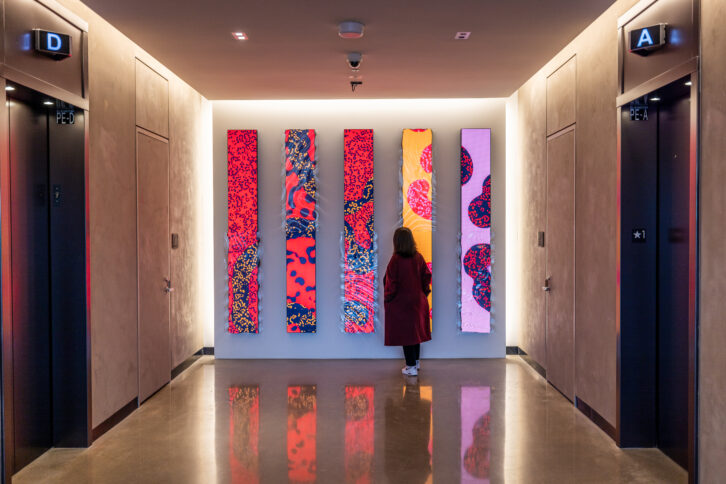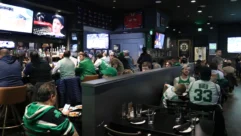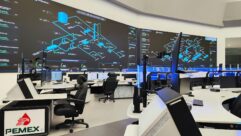
In Somerville, Massachusetts, Boynton Yards is a life science and innovation community near Cambridge’s Kendall Square and a hub where science and culture mix. The first purpose-built lab building in the mixed-use development is a 289,000-square-foot, nine-story facility developed by Leggat McCall Properties that features state-of-the-art research and development lab space, offices, and amenities. In the elevator lobby of the building, a digital art installation combining physical and digital media invites tenants and visitors to explore a series of ever-changing animations representing various patterns found in nature. Created by experiential design firm SOSO, the multimedia piece—named “Observer Effect”—was constructed using five vertically-mounted Planar MGP Series LED video walls (1.5mm pixel pitch) with custom fabricated acrylic lenses positioned over parts of the displays. As viewers move and look at the artwork from different angles, the lenses work to amplify, distort and deconstruct the visuals.
The artwork’s animation is driven by a simulation algorithm called reaction diffusion—a mathematical model corresponding to a wide variety of patterns that occur in the natural world. “It’s a well-published algorithm that can be used to mimic patterns like you would see with sand dunes, cuttle fish skin, sea coral, or zebra stripes,” Rothenberg explained. By its own nature, the algorithm is also unpredictable, said SOSO Designer and Creative Technologist Dalma Földesi. “We designed around that uncertainty to create these sequences of animation at multiple scales that look different at any moment.
Contrary to most LED display applications where the intent is to minimize pixelation, SOSO designed the artwork to embrace the materiality of the display. “In our case, we wanted to play with the pixelation as part of the layers of observation,” Földesi said. “That was our playful approach with the displays and the use of the lenses—as you look at the artwork from different angles, you can see the pixels split into their individual components.” Rothenberg noted that the lensing is very kinetic and responsive to human movement. “Even subtle shifts in your position, like a tilt of the head, will produce a dramatic ripple with what you see in the graphics,” he said. Planar MGP Series LED displays were very effective for SOSO’s purposes and offered the perfect scale for the vertical columns they used. “We had unique mounting requirements for this project—instead of a sixteen by nine screen, we wanted thin bands, high resolution, great visual characteristics and also a reasonable price,” John Rothenberg said. “The Planar MGP Series was great on all those fronts. It made for a really fun canvas for artwork, especially when you get to play with it outside of the typical form factor.”
Leggat McCall Project Manager Rola Idris said, “We wanted to create an experience that inspires and energizes our tenants who pass through the lobby every day. The artwork is never the same at any two moments. The patterns and colors of the piece perpetually change and recombine to make new visuals.”










